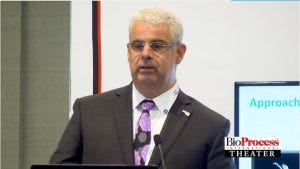- Sponsored Content
- Contract Services
Future-Proofing and Understanding Your Molecule with Contemporary Analytics and Formulation Approaches
August 21, 2018
Sponsored Content
 Greg Adams, senior director of global analytical strategy and development, Fujifilm Diosynth Biotechnologies (FDB)
Greg Adams, senior director of global analytical strategy and development, Fujifilm Diosynth Biotechnologies (FDB)
“Proteins have personalities.” Adams began. Their three-dimensional structures and folding patterns influence how each protein will behave. Analytical methods that evaluate a protein’s quality attributes need to be reproducible and robust. Proteins are evaluated through elucidating their amino acid sequences, using molecular informatics and modeling, characterizing three-dimensional structures, and understanding the degree of posttranslational modifications. The resulting knowledge will help you ensure consistency and safeguard methods.
Adams discussed identifying the critical quality attributes of proteins and offered as examples proteins expressed by Escherichia coli and mammalian cells as well as a monoclonal antibody (MAb). The examples highlighted problems that can occur with each type of protein. Those unique problems need to be considered during development. When approaching the clinical development lifecycle, consider the balance between speed and science. Fortunately, this is a good time for contemporary analytics. Methods offer high resolution with faster and more robust analysis than with previously available systems. Both sample preparation and data processing can be automated. Adams showed six examples of modern rapid methods (SEC UPLC, intact MS, icIEF, circular dichroism, solo VPE, and microfluidic CE-SDS) and what they could measure, and extolled the fact that each method took under 10 minutes to acquire data.
How can you “future proof” analytical methods to support rapid implementation for an early phase process but still prepare for commercialization? You should ensure that methods are suitable for the long-term by working within the methods’ development design spaces, selecting from tried and true equipment and kits, using common standards for method qualification and acceptance criteria, and combining high-end tools for orthogonal characterization.
Adams discussed analytical tests to assess MAb heterogeneity and develop assays. Can you assume that MAbs are all the same and that the same assays can be used on all of them, or should you assume that each MAb has its own personality and needs unique assays? Using past experience, you can determine which methods can remain the same and which need to be optimized for a new MAb. To optimize rapid methods, you can leverage prior knowledge, establish a design space, apply quality by design (QbD) to method development, and evaluate robustness. In an example, Adams showed a sample preparation from a kit with an immunoglobulin G (IgG) purity of 90.5%. But the kit results changed for each antibody. By optimizing the sample preparation with a three-factor design of experiments (DoE) that took only two days to perform, the purity was increased to 98.9%. In this case, resulting data were analyzed using S-Matrix Fusion AE software. Over a 12-month stability study, the results remained consistent.
Formulation development is the experimental design of a buffer and excipient combination. The goal is to maintain integrity of a purified protein during bioprocessing, storage, handling, and delivery to patients. Traditionally, that can take up to 12 months. Formulations undergo multiple laborious tests to discover the best ones that can undergo stability testing. Another approach to shorten that timeline is to use platform formulation development. But doing so assumes that the molecules are highly homologous, which might not be true. By looking at molecular homology models, you can see differences among the MAbs, even those that you might expect to be the same.
You can accelerate formulation development and make scientifically sound decisions. Understanding a protein’s unique “personality” before conducting lengthy screening experiments will help you to select formulation conditions. High-throughput robotic sample preparation, analysis, and biophysical assessments can help complete the formulation selection process. FDB can provide its clients with high-throughput analytics and robotics (the Unchained Labs Freeslate system). Using such systems can narrow the formulation development time to about six weeks. These approaches balance science with speed.
You May Also Like





